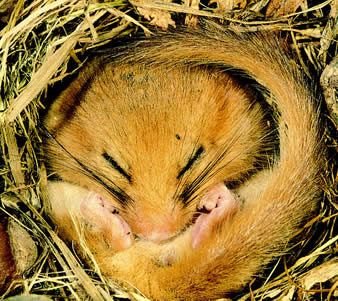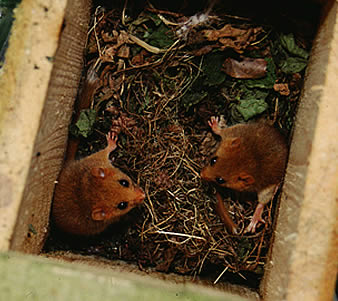DORMOUSE (MUSCARDINUS AVELLANARIUS)
LOCAL BIODIVERSITY ACTION PLAN
Links to associated HAPs
Ancient Semi-Natural Broadleaved Woodland , Ancient and/or species-rich Hedgerows
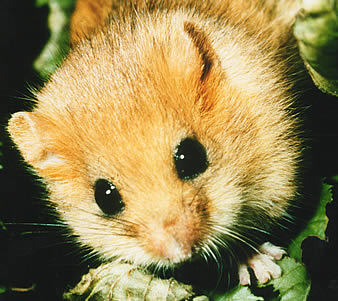 Current Status
Current Status
Nationally, the dormouse has disappeared from most of the north of England. A Mammal Society survey in the late 1970s showed it had become extinct in 7 northern counties where it was once known to occur, including the Cheshire region. The last known dormouse record for the Cheshire region was 1910. Presently, the dormouse occurs mainly in the south of England, where it is widespread, but often with a very patchy distribution.
The only dormice in the Cheshire region are an introduced population in the Wych Valley. This population is the result of the release of captive bred animals - 29 in 1996 and 24 in 1997. Monitoring indicates the dormice have established themselves, with breeding occurring every year from 1996 onwards. The population has grown steadily, with increasing numbers of juveniles recruited into the population each year. The dormice have colonized all parts of the release site and appear to be spreading along the Wych Valley. In 2002/2003 the dormice crossed the Wych Brook into Wrexham (North Wales).
The dormouse is listed on Schedule 5 of the Wildlife & Countryside Act 1981. Listed on Appendix 3 of the Bonn Convention and Annex IVa of the EC Habitats Directive. Schedule 2 of the Conservation (Natural Habitats &c.) Regulations 1994 (Regulation 38). It is on the UK Biodiversity Steering Group Short List of Globally Threatened/Declining Species.
Threats
-
The continual destruction of ancient semi-natural woodlands which are their required habitat.
-
The fragmentation of woodlands is a potential threat. Dormice are reluctant to cross open ground, so are unable to move easily between woodlands (a minimum area of 20ha is required to maintain a viable population).
-
Changes in woodland management, especially the decline in long-rotation hazel coppicing.
-
The continued intrusion of cattle into woodlands, especially during winter.
-
Continual climatic variations.
-
Loss or fragmentation of hedgerows which act as dispersal corridors.
How are we helping to conserve the dormice in the Cheshire region?
-
The decline of the dormouse has led English Nature to include it in their national Species Recovery Programme. This programme includes the reintroduction of dormice to a number of counties where they have been lost. Cheshire Wildlife Trust have managed the reintroduction of dormice to a woodland in the south of the Cheshire region. 300 specially designed dormice nesting boxes have been constructed and put up at the site and boxes are monitored monthly from May to October. Data from the monitoring is passed on to the National Dormouse Monitoring Scheme.
-
A dormouse nestbox sponsorship scheme has been set up, to increase awareness and raise funds. Nestboxes are being located in possible dispersal areas, to monitor expansion of the population.
-
The Wych Valley Project has been set up to promote general conservation in the area, using the dormouse as a flagship.
Objectives, Targets and Actions
OBJECTIVES |
LOCAL TARGETS |
To establish a self-sustaining population at the release site and promote population expansion to adjacent woodlands |
- Carry out monthly monitoring from May to October
- Establish nestboxes in nearby woods to monitor colonisation
|
ACTIONS REQUIRED |
- Construct and establish more nestboxes in adjacent woodland.
-
Continue nestbox monitoring, to monitor breeding success and dispersal. Pass all data on to the National Dormouse Monitoring Scheme.
-
Survey all woodlands and hedgerows within 5km of the current site, to identify possible colonisation areas.
-
Identify any possible sites for planting new woodlands.
-
Produce detailed woodland management guidelines for the immediate area.
-
Implement long-term management guidelines for the immediate area.
-
Incorporate dormouse habitat requirement issues into woodland management initiatives in the Wych Valley area.
-
Improving knowledge and information and subsequently raise public awareness.
-
Inform local residents and land owners of the project and raise awareness of wider conservation issues in the area.
-
Place nestboxes along obvious dispersal routes and monitor population expansion.
-
-
Research into dispersal and possible colonisation areas, using GIS and aerial photographs
-
Investigate use of hair tubes to monitor dispersal.
-
Make contact with dormouse BAP groups in Staffordshire & Shropshire
-
Place more nest boxes on Welsh side of Wych Valley
|
Progress so far
2005 Action Completed |
-
BASC reported a possible Dormouse nest in woodland managed by a BASC syndicate in the south of Cheshire. Working with the Cheshire Wildlife Trust they have erected nest boxes to further establish their presence. They have also erected nesting tubes in a separate wood on the other side of the farm to continue to survey for their presence in the area.
-
Research project initiated in 2005, in partnership with Chester Zoo, Forestry Authority & CCW, looking at dormouse dispersal behaviour, habitat use and population dynamics at two sites, Wych Valley in Cheshire and Bontuchel near Ruthin in north Wales.
|
2004 Action Completed |
-
Nest tubes put up in 2004 in several woods owned/managed by BASC members, to survey for presence of dormice.
-
By the end of 2004 all nest tubes were checked for the presence of dormice.
|
2003 Action Completed |
- Regular monitoring carried out in 2003.
- 50 new boxes put up in adjacent woodland in 2003 to monitor dispersal.
|
1997-2003 Action Completed |
-
A Local BAP Action Group has been set up and meets twice a year.
-
Breeding success confirmed at introduction site over the last 5 years.
-
Nestboxes placed to monitor expansion of the population West-ward along the Wych Valley.
-
In 2000 dormice found for the first time 0.5km west of original release site.
-
Population monitoring carried out every year and results passed on to National Nest box Monitoring Scheme
-
Nest boxes established in nearby woods, to monitor population expansion
-
Liaison with Forest Research, dormouse and conifers project
-
Talks about project to general public / local interest groups
-
All dormouse records passed on to rECOrd.
|
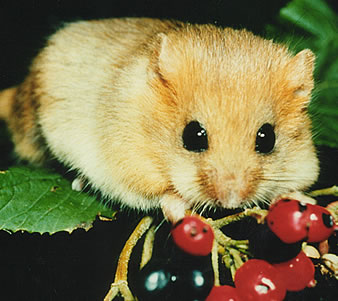 |
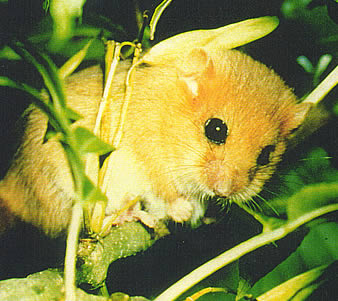 |
How to find out more about Dormice
BBC Wildfacts website - www.bbc.co.uk/nature/wildfacts/factfiles/263.shtml
Great Nut Hunt - www.greatnuthunt.org.uk
The Mammal Society - www.abdn.ac.uk/mammal/dormouse.shtml
UK BAP for Dormice - www.ukbap.org.uk/UKPlans.aspx?ID=462
CWT article - 'Life of the Dormouse'
CWT article - 'Dormouse Reintroduction'
CWT Spring 2006 Project update
How can you get involved?
Join Cheshire Mammal Group. More information can be found at http://www.consult-eco.ndirect.co.uk/lrc/mamg.htm
Sponsor a nestbox with CWT
Nest boxes are an important part of the Cheshire Dormouse Project. Dormice will readily use purpose-built nest boxes. The boxes are built of wood and are similar in design to those frequently put up in gardens for small birds. Indeed, every year we have found birds nesting in our boxes.
You can be involved with the Dormouse Project by sponsoring a nest box. You can sponsor a box for yourself, or as an unusual present to someone else.
For more details click here.
Contact details
| LBAP Chair |
Sue Tatman, Cheshire Wildlife Trust
Phone: 01948 820728 |
National Lead Partners |
The Wildlife Trusts
Natural England |
| National Lead Contact |
Tony Mitchell-Jones, Natural England
Phone: 01733 455250
Mervyn Newman, Devon Wildlife Trust |
References & Glossary
Bright, P. & Morris, P. (1989): A practical guide to Dormouse Conservation. The Mammal Society.
Bright, P. & Morris, P. (1992): The Dormouse. The Mammal Society.
Bright, P., Morris, P. & Mitchell-Jones, T. (1996): Dormouse Conservation Handbook. English Nature


 Current Status
Current Status 